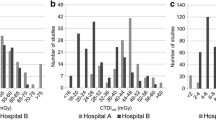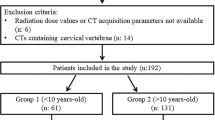Abstract
Cervical spine injuries occur in 4–8 % of adults with head trauma. Dual acquisition technique has been traditionally used for the CT scanning of brain and cervical spine. The purpose of this study was to determine the efficacy of radiation dose reduction by using a single acquisition technique that incorporated both anatomical regions with a dedicated neck detection algorithm. Thirty trauma patients for brain and cervical spine CT were included and were scanned with the single acquisition technique. The radiation doses from the single CT acquisition technique with the neck detection algorithm, which allowed appropriate independent dose administration relevant to brain and cervical spine regions, were recorded. Comparison was made both to the doses calculated from the simulation of the traditional dual acquisitions with matching parameters, and to the doses of retrospective dual acquisition legacy technique with the same sample size. The mean simulated dose for the traditional dual acquisition technique was 3.99 mSv, comparable to the average dose of 4.2 mSv from 30 previous patients who had CT of brain and cervical spine as dual acquisitions. The mean dose from the single acquisition technique was 3.35 mSv, resulting in a 16 % overall dose reduction. The images from the single acquisition technique were of excellent diagnostic quality. The new single acquisition CT technique incorporating the neck detection algorithm for brain and cervical spine significantly reduces the overall radiation dose by eliminating the unavoidable overlapping range between 2 anatomical regions which occurs with the traditional dual acquisition technique.




Similar content being viewed by others
References
Holly LT, Kelly DF, Cournelis GJ, Blinman T, McArthur DL, Cryer HG (2002) Cervical spine trauma associated with moderate and severe head injury: incidence, risk factors and injury characteristics. J Neurosurg 96(3 Suppl):285–291
Paiva WS, Oliveira AMP, Andrade AF, Amorim RLO, Lourenço LJO, Teixeira MJ (2011) Spinal cord injury and its association with blunt head trauma. Int J Gen Med 4:613–615
Garfin SR, Shackford SR, Marshall LF, Drummond JC. (1989) Care of the multiply injured patient with cervical spine injury. Clin Orthop Relat Res. Feb 239:19–29
Sanchez B, Waxman K, Jones T, Connor S, Chung R, Becerra S (2005) Cervical spine clearance in blunt trauma: evaluation of a computed tomography-based protocol. J Trauma 59(1):179–83
Griffen MM, Frykberg ER, Kerwin AJ, Schinco MA, Tepas JJ, Rowe K, Abboud J (2003) Radiographic clearance of blunt cervical spine injury: plain radiograph or computed tomography scan? J Trauma 55(2):226–7
Padayachee L, Cooper DJ, Irons S, Ackland HM, Thomson K, Rosenfeld J, Kossmann T (2006) Cervical spine clearance in unconscious traumatic brain injury patients: dynamic flexion-extension fluoroscopy versus computed tomography with three-dimensional reconstruction. J Trauma 60(2):341–5
Crim JR, Moore K, Brodke D (2001) Clearance of the cervical spine in multitrauma patients: the role of advanced imaging. Semin Ultrasound CT MR 22(4):283–305
Gale SC, Gracias VH, Reilly PM, Schwab CW (2005) The inefficiency of plain radiography to evaluate the cervical spine after blunt trauma. J Trauma 59(5):1121–5
Ma S, Kong B, Liu B, Liu X (2013) Biological effects of low-dose radiation from computed tomography scanning. Int J Radiat Biol 89(5):326–33
Brenner DJ, Hall EJ (2007) Computed Tomography—an increasing source of radiation exposure. N Engl J Med 357:2277–84
Christner JA, Zavaletta VA, Eusemann CD, Walz-Flannigan AI, McCollough CH (2010) Dose reduction in helical CT: dynamically adjustable z-axis X-ray beam collimation. Am J Roentgenol 194(1):W49–55
Huggett J, Mukonoweshuro W, Loader R (2013) A phantom-based evaluation of three commercially available patient organ shields for computed tomography X-ray examinations in diagnostic radiology. Radiat Prot Dosimetry 155(2):161–8
Halpin SFS (2004) Brain imaging using multislice CT: a personal perspective. Br J Radiol 77:S20–S26
Conflict of interest
This project was not financially sponsored. Nicholas Ardley and Ken Lau declare that they have no conflict of interest. Kevin Buchan is an employee of Philips Healthcare in the department of Clinical Science.
Author information
Authors and Affiliations
Corresponding author
Rights and permissions
About this article
Cite this article
Ardley, N.D., Lau, K.K. & Buchan, K. Radiation dose reduction using a neck detection algorithm for single spiral brain and cervical spine CT acquisition in the trauma setting. Emerg Radiol 20, 493–497 (2013). https://doi.org/10.1007/s10140-013-1145-5
Received:
Accepted:
Published:
Issue Date:
DOI: https://doi.org/10.1007/s10140-013-1145-5




